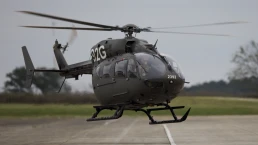Flight School Next
The Army's next generation flight school trainer is already here.
In 2015, the Army made an excellent decision by repurposing the UH-72A Lakota to support and sustain the Initial Entry Rotary Wing (IERW) training mission at the Army Aviation Center of Excellence. Since then, all future aviators have received their initial rotary wing training, instrument procedures, warfighter skills, and emergency procedures in the UH-72A Lakota, a modern, dual-engine, Single Pilot IFR-capable aircraft, before transitioning to their advanced aircraft. Initial training in this modern aircraft has transformed the nature of military flight training. In October 2024, the Army issued a request for information asking industry how they could fundamentally transform its flight school model. Airbus envisions a modern, proficiency-based flight school using the most advanced helicopter ever used as a flight school trainer, coupled with modern technology. This model will replace rote memorization, student handouts, and podium instruction with fundamentals of the experience-based learning model. It will provide our nation's rotary wing student aviators with the necessary fundamentals to counter and defeat our adversaries. What makes the UH-72 Lakota the top choice for primary training aircraft?
The Lakota has trained over 8,000 students and has accumulated over 675,000 flight hours since it became the primary trainer in 2020. Fort Novosel has never had a fatal mishap with this training aircraft, making it the safest in their history. The Lakota has the lowest NMCS rate across the Army fleet. The Army can train 40% more pilots and fly 40% more hours with 40% fewer aircraft due to the aircraft's proven performance.
Affordability, Flexibility and Reliability
The U.S. Army's Combat Training Centers (CTCs) put more than 140,000 soldiers through realistic combat and threat training scenarios annually. These CTCs utilize the UH-72A as observer and controller and opposing force aircraft for Joint and Combined Arms Forces training. No other training aircraft in the Army fleet offers a similar affordability, flexibility, reliability, and seamless transition to advanced aircraft. The CTCs are located at the National Training Center, Fort Irwin, CA; the Joint Readiness Training Center at Fort Johnson, LA and the Joint Multinational Readiness Center at Hohenfels, Germany.
Need More Information?Contact Us.
Need More Information?Contact Us.
Need More Information?Contact Us.



